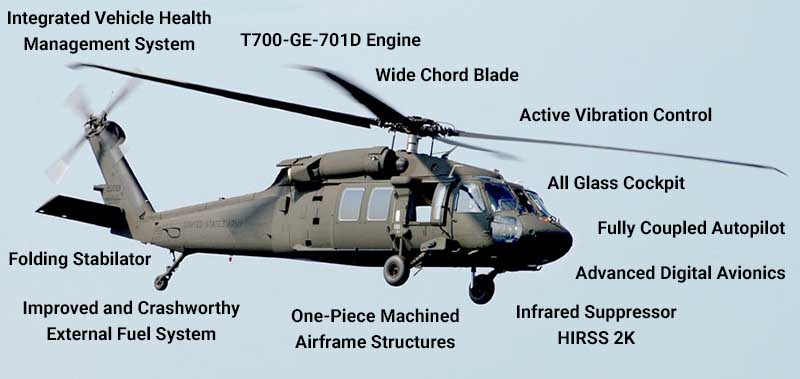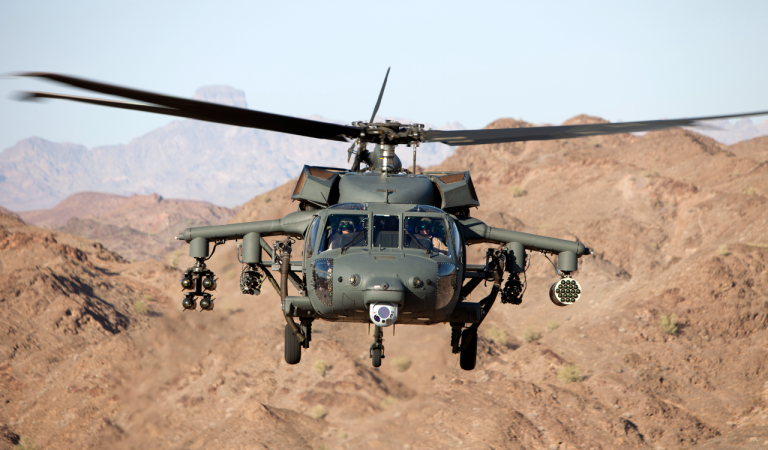UH-60: Developments in Modern Helicopter Design
The UH-60 helicopter stands as a benchmark in modern aeronautics, showcasing considerable developments in design and technology that accommodate the progressing demands of army procedures. Its incorporation of innovative products not only boosts efficiency but additionally addresses important security concerns. In addition, the combination of sophisticated avionics has actually transformed functional abilities, enabling higher situational awareness and decision-making performance. As we check out the advancement and essential technologies of the UH-60, it ends up being essential to think about how these advancements affect not only present applications yet likewise the future landscape of helicopter layout.

Development of the UH-60
The evolution of the UH-60 Black Hawk helicopter stands for a considerable milestone in aerospace design and armed forces air travel. Introduced in the late 1970s, the UH-60 was created by Sikorsky Aircraft to meet the USA Army's demand for a functional energy helicopter with the ability of executing a range of missions. Its layout highlighted speed, ability to move, and resilience, establishing new criteria for operational efficiency.
The UH-60 includes an unique four-blade blades system, which enhances lift and security, permitting it to operate properly in diverse atmospheres. Its airframe is created from sophisticated composite products, contributing to a reduction in weight while keeping structural stability. The helicopter's layout additionally incorporates enhanced the rules of aerodynamics, which enhances fuel effectiveness and boosts range.
Over the years, the Black Hawk has actually undergone several upgrades to boost its capabilities, including enhanced engines, progressed flight control systems, and modular systems for easy maintenance and flexibility. The helicopter's capacity to perform objectives varying from army transportation to clinical evacuation has solidified its function as a foundation of united state army procedures. The UH-60 Black Hawk remains a prime example of exactly how technology in helicopter design can significantly affect armed forces efficiency and functional versatility.
Advanced Avionics Equipments
Innovations in avionics systems have actually changed the capacities of modern-day helicopters like the UH-60 Black Hawk, boosting functional performance and situational recognition (UH 60). The assimilation of innovative avionics permits boosted interaction, flight, and navigation administration, making the UH-60 a lot more flexible in diverse mission accounts
Among the crucial functions is the advanced digital cabin, which utilizes multifunction screens that offer real-time data, ensuring pilots have prompt accessibility to vital flight information. This streamlining of details lessens pilot workload and enhances decision-making procedures during complex procedures. Furthermore, the consolidation of general practitioner and inertial navigating systems allows precise positioning and course planning, improving goal execution in tough atmospheres.
Furthermore, progressed avionics systems improve communication capacities with secure information links and voice interaction systems, enabling seamless sychronisation with ground forces and various other aircraft. The assimilation of automatic trip control systems even more adds to improved security and control, particularly in damaging weather condition problems or during low-altitude maneuvers.
Engine and Efficiency Enhancements
Engine performance in modern-day helicopters has taken a considerable leap ahead, driven by innovations that improve power, reliability, and effectiveness. At the center of these advancements is the adoption of even more effective turboshaft engines, particularly those utilizing innovative products and technologies that allow greater temperature level tolerances and enhanced drive capacities. The UH-60 Black Hawk, for example, utilizes the T700-GE-701C engine, which features a dual-channel, full-authority digital engine control system. This system boosts efficiency while maximizing fuel consumption and minimizing upkeep demands.
Furthermore, the integration of engine health monitoring systems allows for real-time diagnostics and anticipating upkeep, dramatically boosting functional dependability. These systems not only alert crews to potential concerns prior to they end up being vital however also facilitate more reliable upkeep scheduling, thus reducing downtime.

Materials and Structural Innovations
Current advancements in products and architectural layout have actually revolutionized modern helicopter building, improving both performance and toughness. The intro of innovative composite products, such as carbon fiber enhanced polymers, has actually dramatically lowered weight while keeping architectural honesty. This change not just boosts gas effectiveness however likewise enhances payload capacity, allowing helicopters like the UH-60 to perform even more varied goals.
In addition, advancements in aluminum alloys and titanium components have actually added to improved resistance to corrosion and exhaustion, prolonging the lifespan of critical airframe components. The calculated use these products has led to a reduction in upkeep demands and improved total operational preparedness.

Additionally, the integration of computer-aided layout (CAD) and additive manufacturing modern technologies has allowed more complicated geometries and lightweight structures, optimizing the aerodynamic efficiency of helicopter designs. These improvements facilitate fast prototyping and manufacturing, allowing makers to react swiftly to progressing mission needs.
Security and Survivability Features
Security and survivability functions in modern-day helicopter design have come to be paramount, reflecting the boosting needs for mission efficiency in tough settings. The UH-60 Black Hawk, a notable example, incorporates innovative modern technologies to enhance crew and traveler security. Among one of the most critical developments is the consolidation of crashworthy gas systems made to decrease the risk of fire during impact. Additionally, read this article the airframe is built with strengthened products that soak up and dissipate power, more shielding passengers in case of a collision.
The helicopter likewise utilizes a ballistic security system, that includes armored crew seats and essential systems securing, minimizing vulnerability to small arms fire and shrapnel. Enhanced situational recognition is accomplished with advanced avionics and sensing unit innovations, enabling pilots to spot and avoid hazards properly.
Additionally, the integration of redundancy in critical systems-- such as twin engines and several flight control networks-- guarantees continued procedure even if one system falls short. The UH-60 is furnished with advanced emergency situation flotation devices, improving survivability in water landings. Jointly, these navigate here features not only enhance the safety of employees however additionally enhance goal success rates in aggressive atmospheres, showing the commitment to quality in helicopter design.
Verdict
The UH-60 helicopter stands for a substantial advancement in modern air travel innovation, including cutting-edge materials, cutting-edge avionics, and robust security functions. navigate to these guys Generally, the UH-60 offers as a standard for future growths in helicopter design, embodying resilience and flexibility in contemporary military operations.
The UH-60 helicopter stands as a criteria in contemporary air travel, showcasing considerable developments in style and innovation that cater to the evolving demands of military procedures. As we discover the advancement and vital technologies of the UH-60, it comes to be necessary to take into consideration exactly how these advancements influence not only existing applications yet additionally the future landscape of helicopter style.
Introduced in the late 1970s, the UH-60 was designed by Sikorsky Airplane to fulfill the United States Military's requirement for a versatile energy helicopter qualified of carrying out a variety of goals. The UH-60 Black Hawk continues to be a prime example of how innovation in helicopter layout can substantially affect military performance and functional flexibility.
On the whole, the UH-60 offers as a benchmark for future growths in helicopter style, embodying strength and convenience in contemporary army procedures.